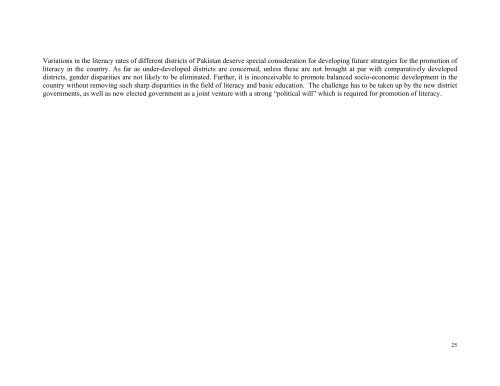Literacy Trends in Pakistan - UNESCO Islamabad
Literacy Trends in Pakistan - UNESCO Islamabad Literacy Trends in Pakistan - UNESCO Islamabad
District has progressed from a very low to only a low literacy level region. This transition is probably due to the increase in participation rate inthese districts as compared to that of 1981.From total scenario, it is apparent from Table 10 that a total of 83 districts of Pakistan are in the region of “low literacy” and “very low literacy”,while only 21 districts are in the region of high literacy or very high literacy. None of the districts of the provinces of NWFP and Balochistanare in the region of “very high literacy”, while only 2 districts of NWFP and none of the districts of Balochistan lie in the region of “high literacyrate”. It is also indicative that shifts of districts to high literacy regions from low literacy regions, between 1981 to 1988, were mostly in theprovinces of the Punjab and Sindh. The provinces of Balochistan and NWFP have progressed very slowly in respect of literacy rate, during thisperiod of 17 years (1981-98).It is also observed from provincial statistics that in 1981 a higher percentage (26.15) of the districts were in the region of high literacy ascompared to 1998 (20.19). Major shifts as revealed in Table No. 9 are from regions of “very low literacy” to the region of low literacy. About23 districts from all over Pakistan have moved from the region of “very low literacy” to the region of “low literacy”, during these 17 years. Thefollowing table presents further details:-Table 10Number of Districts in Various Literacy Regions (1981-98)Area Years Number of Districts in:Very High literacyRegions (60.70 % andHigh literacy Regions(45.93 to 60.70 %)above)Low literacy regions(45.93 % to 60.70 %)Very low literacy regions(30.16 % to 45.93%)PUNJAB 1981 03 07 15 ---- 251998 04 09 18 03 34SINDH 1981 02 03 03 01 091998 03 03 09 06 21NWFP 1981 --- 01 08 03 121998 --- 02 13 09 24BALO-CHISTANALLPAKIS-TANTotalDistricts1981 --- 01 --- 15 161998 --- 01 03 22 261981 05 12 26 19 621998 07 15 43 40 10524
Variations in the literacy rates of different districts of Pakistan deserve special consideration for developing future strategies for the promotion ofliteracy in the country. As far as under-developed districts are concerned, unless these are not brought at par with comparatively developeddistricts, gender disparities are not likely to be eliminated. Further, it is inconceivable to promote balanced socio-economic development in thecountry without removing such sharp disparities in the field of literacy and basic education. The challenge has to be taken up by the new districtgovernments, as well as new elected government as a joint venture with a strong “political will” which is required for promotion of literacy.25
- Page 2 and 3: ContributorsDescription and Analysi
- Page 4 and 5: Literacy Trends in PakistanUNESCO O
- Page 6 and 7: Part I - An Analysis of Literacy Tr
- Page 8 and 9: Part II Statistical Tables (Based o
- Page 10 and 11: an education that includes learning
- Page 12 and 13: district. This information on liter
- Page 14 and 15: In the present day context, when pa
- Page 16 and 17: 7. FUNCTIONAL LITERACYThe definitio
- Page 18 and 19: Middle Level (Level II)A) TARGET GR
- Page 20 and 21: Table - 3Comparison of Pakistan wit
- Page 22 and 23: Previous attempts made for the enha
- Page 24 and 25: 11. CURRENT LITERACY SITUATION IN P
- Page 26 and 27: Graph No. 1Growth of Literacy Rate
- Page 28 and 29: Table 7 below indicates the highest
- Page 30 and 31: Table 8Literacy Growth Rate Trends
- Page 34 and 35: Table 11Districts in Various Litera
- Page 36 and 37: 13.2 Public Expenditure on Primary
- Page 38 and 39: lowest female literacy rate in Paki
- Page 40 and 41: All this suggests that a considerab
- Page 42 and 43: Graph No.4LITERACY RATE DIRECTLY EF
- Page 44 and 45: 16. LITERACY AND NATIONAL PLAN OF A
- Page 46 and 47: 17.1 Why has it been established?Th
- Page 48 and 49: Table 16 - Focus Areas and Key Stra
- Page 50 and 51: 17.5 Resource MobilizationThe Liter
- Page 52 and 53: PART - IIStatistical Tables(Based o
- Page 57: Table IILiteracy Rates (10 Years &
- Page 62: Growth RateYearsAll Areas Urban Rur
- Page 66 and 67: N.W.F.P.1972 15.50 23.10 4.701981 1
- Page 71 and 72: Table VLiteracy Rates (10 Years & a
- Page 74 and 75: Table VI-ADistrict-wise Rate (10 Ye
- Page 76 and 77: Province/DistrictBoth Male Female B
- Page 78 and 79: Province/DistrictBoth Male Female B
- Page 80 and 81: Province/DistrictBoth Male Female B
Variations <strong>in</strong> the literacy rates of different districts of <strong>Pakistan</strong> deserve special consideration for develop<strong>in</strong>g future strategies for the promotion ofliteracy <strong>in</strong> the country. As far as under-developed districts are concerned, unless these are not brought at par with comparatively developeddistricts, gender disparities are not likely to be elim<strong>in</strong>ated. Further, it is <strong>in</strong>conceivable to promote balanced socio-economic development <strong>in</strong> thecountry without remov<strong>in</strong>g such sharp disparities <strong>in</strong> the field of literacy and basic education. The challenge has to be taken up by the new districtgovernments, as well as new elected government as a jo<strong>in</strong>t venture with a strong “political will” which is required for promotion of literacy.25



